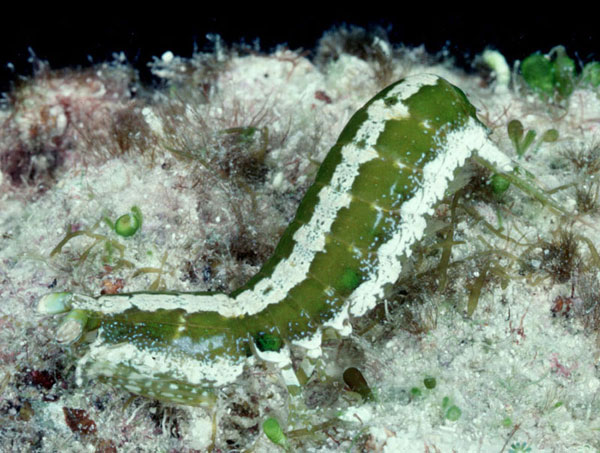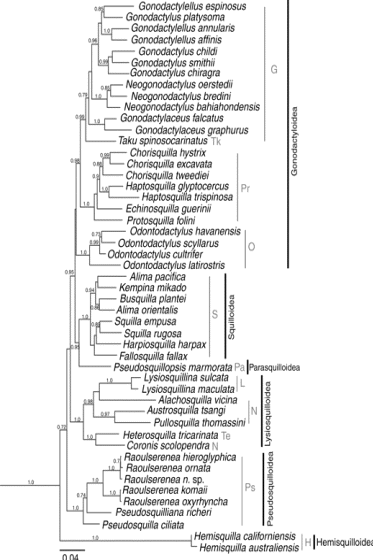Where do I fit in? (Classification)
Domain - Eukarya
Kingdom - Animalia
Phylum - Arthropoda
Class - Malacostraca
Order - Stomatopods
Family - Pseudosquillae
Genus - Pseudosquilla
Species - ciliata
Pseudosquillia ciliata is known to many people by the common names: mantis shrimp, rainbow mantis, checkered eye mantis and many more (Campbell, 2012). In English, this organisms name means Flase shrimp (Campbell, 2012). The mantis shrimp are found in the domain of Eukarya because it possesses a nucleus as well molecular evidence (Campbell, 2012). The domain Eukarya shares a most recent common ancestor with the domain Archaea because they have a synapomorhpy of molecular evidence, but what distinctly sets them apart from each other is the trait of the nucleus.
Like with all organisms of the kingdom Animalia, P. ciliata are
multicellular and are heterotrophic (Campbell, 2012). They obtain their
energy
mostly by eating other organisms
organisms
whether it’s by parasitism, decomposing it, or just plain consumption. The kingdom Animalia can be found in the clade Opistokonta because they have a posterior flagellum at some point in their life. But what separates this phyla from Fungi is the cell membrane animals possess, Fungi have a cell wall made of chitin.
Going down the phylogenic tree, P.ciliata belongs in the phyla Arthropoda (Campbell, 2012). Organisms in this phyla have distinct synapmomorphies like an exoskeleton that aids in locomotion, protection and support as well as jointed legs and appendages (Campbell, 2012). Specifically, Pseudosquilla ciliata they have bilateral symmetry categorizing them into a sub-phyla of Bilateria (Campbell, 2012). Many organisms have bilateral symmetry
meaning that if cut in half, these two halfs are relatively the same. Arthropods have at least one set of appendages for walking, but every species has modified their other appendages in a way that suits them best (Arthropods, 2013). The species we researched P. ciliata has modified their appendages for spearing and protection (Arthropods, 2013).
All of the information in this paragraph is from Cooper’s article written in 2010. Mantis shrimp belong to the class Malacostraca. Specifically crayfish and their relatives are in this class. All species have a compound stalk eye, central nervous system, and two chambered stomach. Attached to the abdomen are swimmerets, these organisms use these for swimming, catching food, and for many other important purposes. Along with these swimmerets, Malacostraca generally have four pairs of legs. Overtime, species who belong to this class have used their front pair of legs as a pair of pinchers.
Stomatopoda is the order in which you will find P.ciliata (Hammock, 2012). Stomatopods are the mantis shrimp (click the link to learn more about a different mantis shrimp). Often times P.ciliata are often just referred to as mantis shrimp (Campbell, 2012). Most mantis shrimp inhabit tropical waters, thus they are predominantly found in coral reefs (Hammock, 2012). But specifically you can easily find them in tropical shallow waters (Hammock, 2012).
P. ciliata is part of the Pseudosquillidae family (Campell, 2012). This family classification is due to the synapomorphy of distal movable spines (Hammock, 2012). Other organisms in this family, obtain raptorial claws as well as teeth, and their abdomens typically are made of six unfused segments that profide them with more flexibility than one might presume (Hammock, 2012).
In this specific tree, it shows P. ciliata sharing a most recent common ancestor with multiple other stomatopods.This tree is based on the appendage morphologies of these different mantis shrimp; you can see similarities throughout the appendages.

This Tree shows the relations of the P. ciliata to all of the other types and genuses of Stomatopods. P. ciliata shares a most recent common ancestor with the Pseudosquillianae and the
Raoulsernea.
Click to continue to the Habitat!
